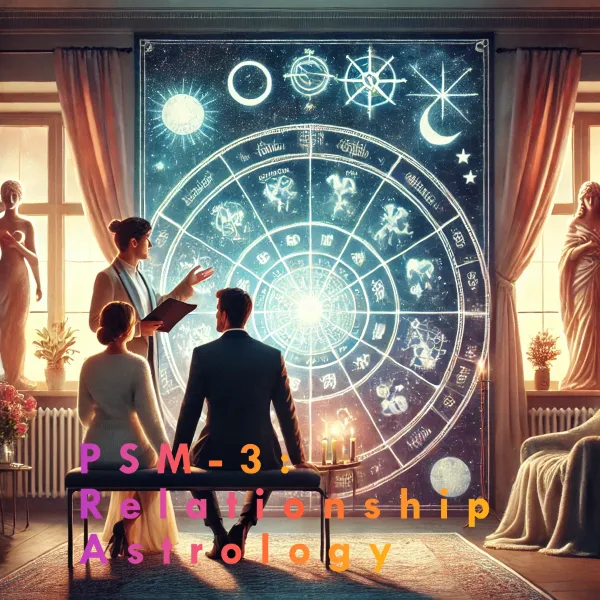PSM-3: Relationship Astrology

Prerequisites: This course is open to the general public. IAA Diploma Program students must have satisfactorily completed the Natal Studies Module and PSM-1.
Course Description:
This course focuses on one of the things clients ask about most: relationships. We begin by investigating the potential relationship themes in the natal chart and then explore synastry between two charts, midpoint composites and Davison time-space composites. We also take a look at family and group dynamics.
Classes are held weekly.
Class Meeting 1: Relationship Patterns: The Capacity for Relationship
In this class the student learns there is more to relationship dynamics than just the 7th house and Venus. First, as an essential foundation, we will look at each natal chart of a selected couple to understand the “capacity for relationship” that each individual brings through their own natal chart patterns. Students will choose the same two individuals to use for the relationship classes.
Class Meeting 2: Relationship Patterns & Synastry
The student will explore the relationship pattern of two individuals they will use for further relationship study.
Next, we look at synastry. Both people are explored on a bi-wheel, with each person getting a change to be in the middle with their house cusps. We will look at inter-aspects between the two people to show how they play into each other’s pattern, compliment where one is lacking, and glean what they can learn about themselves from the relationship with the other. We will also explore where their planets fall in the other's houses and how that adds significance.
Class Meeting 3: The Midpoint Composite
The midpoint composite takes each person's Sun and calculates the midpoint for the composite Sun, etc. for all planets and angles. Therefore, this chart is a symbolic representation of where each of the individual energies come together.
This week we will calculate the midpoint composite chart and examine it as a chart that represents the relationship. We will also explore where each person's planets fall in the relationship chart to gain insight into what each one contributes or learns in the relationship. We will also pick a relationship event (marriage, moving in together, going on a trip together, birth of a child, etc) and explore the transits to the relationship chart on that date.
Class Meeting 4: The Davison Composite
The Davison Composite takes the midpoint of birth date and time along with the midpoint of birth location of both people to arrive at the midpoint in time and space. If two people were born 2 years, 2 months and 2 hours apart the midpoint would be 1 year, 1 month, and 1 hour ahead of the older person's birth and behind from the younger person's birth. It does the same for the midpoint of longitude and latitude. Therefore this chart exists in real time. The planets actually did simultaneously occupy the positions they show in the chart. This chart shows the relationship purpose.
We will not calculate this chart, we will use our software. We will examine the similarities and differences between the time-space composite and the midpoint composite. We will also look at where each person's planets fall in the Davison houses. Finally, we will progress the Davison chart to a relationship event date and examine the transits.
Class Meeting 5: Family and Group Dynamics
This week we will explore group dynamics in class using the combined synastry of your class mates. Since you've probably been with each other for several semesters, a look at the group composite among students should confirm what you probably already know by this point, why you are here studying together. We'll explore what you contributed and what you learned from each other. The homework will be to explore your own birth family dynamics.
Class Meeting 6: Review of Synastry, Combined Charts
Class Meeting 7: Planetary Resonance Cycles
Planetary Resonance is a method created by Dorothy Oja to detail and examine the influence and residues left behind by the transits of the three outermost planets Uranus, Neptune ad Pluto. The essence of this method presupposes that the effect of these planetary transits remain, a residue lingers - from, primarily, the Ptolemaic hard aspects (4th harmonic) - until the next transit to the same planet by one of these three transformers of life. Planetary resonance cycles of Uranus, Neptune and Pluto to one of your planets may last a few weeks, months, or years depending on how these planets are configured in the sky, at any given time, and their relationship to your natal planets. Saturn and Jupiter (sub-cycles) show the expansions and contractions within these larger planetary resonance cycles. We will examine this method, that I call the Western answer to Vedic Planetary Periods - in relation to to your Venus or Mars.
Class Meeting 8: Practice: Synastry and Combined Charts
Class Meeting 9: Final Exam
We will use this class time to review any elements from previous classes, answer questions you may have and then get a head start on your final exam.
Required materials:
The following required materials are available through the IAA online shopping areas:
Beyond Basics: Tools for the Consulting Astrologer, by Carol A. Tebbs
Planets in Therapy: Predictive Technique and the Art of Counseling, by Greg Bogart
Eclipses and You: How to Align with Life’s Hidden Tides, by Judith Hill
Suggested/supplemental materials:
The following suggested and supplementary materials are available through the IAA online shopping areas:

